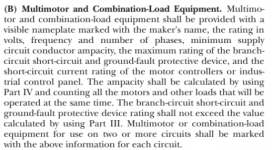- Location
- Illinois
- Occupation
- retired electrician
Branch circuit selection current only exists where the internal overload protection exceeds 156%. That is not a common condition.Branch circuit selection current is higher than RLA, not MCA.
MCA is based on 125% of branch circuit selection current.
The MCA for equipment that does not have overload protection exceeding 156% is the sum of the rated load current of all motors, plus 25% of the rated load curren of the largest motor.


